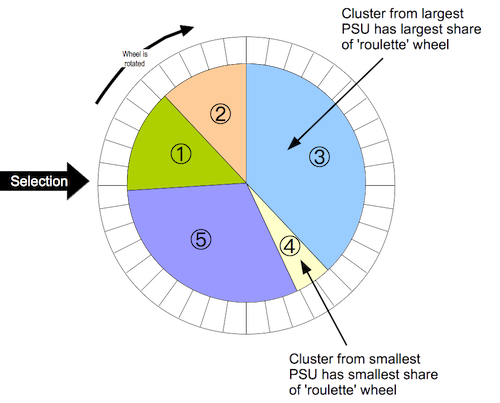
Blocked Weighted Bootstrap
Mark Myatt and Ernest Guevarra
6 January 2025
Source:vignettes/bbw.Rmd
bbw.RmdThe blocked weighted bootstrap is an estimation technique for use with data from two-stage cluster sampled surveys in which either prior weighting (e.g. population-proportional sampling (PPS) as used in Standardized Monitoring and Assessment of Relief and Transitions (SMART) surveys) or posterior weighting (e.g. as used in Rapid Assessment Method (RAM) and Simple Spatial Sampling Method (S3M)surveys).
Features of blocked weighted bootstrap
The bootstrap technique is described in this article. The blocked weighted bootstrap used in RAM and S3M is a modification to the percentile bootstrap to include blocking and weighting to account for a complex sample design.
With RAM and S3M surveys, the sample is complex in the sense that it is an unweighted cluster sample. Data analysis procedures need to account for the sample design. A blocked weighted bootstrap can be used:
Blocked: The block corresponds to the primary sampling unit (
PSU = cluster). PSUs are resampled with replacement. Observations within the resampled PSUs are also sampled with replacement.Weighted: RAM and S3M samples do not use population proportional sampling (PPS) to weight the sample prior to data collection (e.g. as is done with SMART surveys). This means that a posterior weighting procedure is required. bbw uses a “roulette wheel” algorithm (see Figure 1 below) to weight (i.e. by population) the selection probability of PSUs in bootstrap replicates.

Posterior weighting through resampling
In the case of prior weighting by PPS all clusters are given the same weight. With posterior weighting (as in RAM or S3M) the weight is the population of each PSU. This procedure is very similar to the fitness proportional selection technique used in evolutionary computing.
A total of m PSUs are sampled with replacement for each
bootstrap replicate (where m is the number of PSUs in the
survey sample).
The required statistic is applied to each replicate. The reported estimate consists of the 0.025th (95% LCL), 0.5th (point estimate), and 0.975th (95% UCL) quantiles of the distribution of the statistic across all survey replicates.
Development history
Early versions of the bbw did not resample observations within PSUs following:
Cameron AC, Gelbach JB, Miller DL, Bootstrap-based improvements for inference with clustered errors, Review of Economics and Statistics, 2008:90;414–427 https://www.nber.org/papers/t0344
and used a large number (e.g. 3999) survey replicates.
Next versions (up to v0.2.0) of the bbw resample
observations within PSUs and use a smaller number of survey replicates
(e.g. n = 400). This is a more computationally efficient
approach and is demonstrated in the following:
Aaron GJ, Sodani PR, Sankar R, Fairhurst J, Siling K, Guevarra E, et al. (2016) Household Coverage of Fortified Staple Food Commodities in Rajasthan, India. PLoS ONE 11(10): e0163176. https://doi.org/10.1371/journal.pone.0163176
Aaron GJ, Strutt N, Boateng NA, Guevarra E, Siling K, Norris A, et al. (2016) Assessing Program Coverage of Two Approaches to Distributing a Complementary Feeding Supplement to Infants and Young Children in Ghana. PLoS ONE 11(10): e0162462. https://doi.org/10.1371/journal.pone.0162462
The current version (v0.3.0) now includes further improvements in computational efficiency using a vectorised algorithm and provides an option for parallel computation which when used reduces the computational overhead by at least 80%.
Advantages
The main reason to use bbw is that the bootstrap allows a wider range statistics to be calculated than model-based techniques without resort to grand assumptions about the sampling distribution of the required statistic. A good example for this is the confidence interval on the difference between two medians which might be used for many socio-economic variables. The bbw also allows for a wider range of hypothesis tests to be used with complex sample survey data.